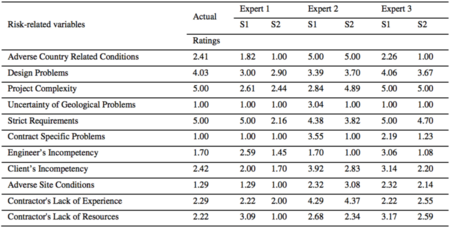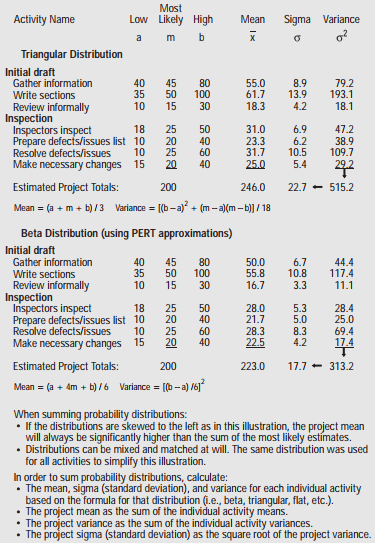Risk Quantification
| Line 32: | Line 32: | ||
|} | |} | ||
| − | + | [[File:Risk Matrix of a project.jpg|thumb| |upright=2.5||right||Figure 1: Example of risk matrix of a project (source: http://www.cbisco.com.au/wp-content/uploads/2014/06/aa.jpg)]] | |
===Purpose and Concept === | ===Purpose and Concept === | ||
| − | |||
<div style="text-align: justify;">The objective of risk quantification is to prioritize them in terms of their severity and likelihood, so that appropriate action can be taken accordingly. In order to quantify risk, it needs to be identified first. Once risk is identified then it is analyzed in terms of probability of occurrence and impact that it could print on the outcome. The probability is assigned based on the previous data of failure rates available for similar events in datasheets. Probability of failure on Demand (PFD) of an event or a component is calculated by following formula. </div><br /> | <div style="text-align: justify;">The objective of risk quantification is to prioritize them in terms of their severity and likelihood, so that appropriate action can be taken accordingly. In order to quantify risk, it needs to be identified first. Once risk is identified then it is analyzed in terms of probability of occurrence and impact that it could print on the outcome. The probability is assigned based on the previous data of failure rates available for similar events in datasheets. Probability of failure on Demand (PFD) of an event or a component is calculated by following formula. </div><br /> | ||
| Line 52: | Line 51: | ||
=Applications= | =Applications= | ||
| − | |||
<div style="text-align: justify;">Several tools and techniques are used in order to apply risk quantification in projects. PMBOK <ref name=Duncan2013 /> provides 6 methods that can be used in risk quantification process. These tools and techniques are described briefly below, along with application, advantages, and disadvantages of each tool. </div><br /> | <div style="text-align: justify;">Several tools and techniques are used in order to apply risk quantification in projects. PMBOK <ref name=Duncan2013 /> provides 6 methods that can be used in risk quantification process. These tools and techniques are described briefly below, along with application, advantages, and disadvantages of each tool. </div><br /> | ||
| − | ===Expert Opinion | + | [[File:Example of Expert Opinion.png|thumb| |upright=2.5||right||Figure 3: Example of expert opinion in a project (source: Yildiz A. Z. et al, “Using expert opinion for risk assessment: a case study of a construction project utilizing a risk mapping tool “, Procedia - Social and Behavioral Sciences, (2014), Vol. 119, pp. 519-528.)]] |
| − | <div style="text-align: justify;">[https://www.merriam-webster.com/dictionary/expert%20opinion Merriam Webster]defines expert opinion as, “a belief or judgment about something given by an expert on the subject”. Expert opinion is one of the risk quantification techniques. In expert opinion, risks are quantified based on the opinions of experts or senior executives based on their experiences. One of the best ways to use expert opinion is to conduct risk assessments workshops where experts can discuss and consequently assign values to the to the risks identified. But, this may lead to group bias and can affect the outcome. This bias can be minimized by using Delphi method, but there still be a chance of high variation in opinion. [http://www.theactuary.com/archive/old-articles/part-3/risk-quantification-techniques/] Although, expert opinion is not as concrete, as other methods may be, and may prone to personal subjectivity, but it is a very useful tool for risk quantification when data is scarce or no sufficient past experience is available or where risks are very company or project specific.[http://www.theactuary.com/archive/old-articles/part-3/risk-quantification-techniques/] Figure 3 shows an example of risk quantification using expert opinion in a case study on construction project conducted by Yildiz et al. (2014).<ref>[Yildiz A. Z. et al, “Using expert opinion for risk assessment: a case study of a construction project utilizing a risk mapping tool “, Procedia - Social and Behavioral Sciences, (2014), Vol. 119, pp. 519-528.]</ref> The ratings are estimated ratings, quantified by SEM (Structural Equation Modeling) [https://en.wikipedia.org/wiki/Structural_equation_modeling] software based on the sub risks and attributes ratings assigned by experts using 1-5 Likert Scale.[https://da.wikipedia.org/wiki/Likert-skala]</div><br /> | + | ===Expert Opinion=== |
| + | <div style="text-align: justify;">[https://www.merriam-webster.com/dictionary/expert%20opinion Merriam Webster]defines expert opinion as, “a belief or judgment about something given by an expert on the subject”. Expert opinion is one of the risk quantification techniques. In expert opinion, risks are quantified based on the opinions of experts or senior executives based on their experiences. One of the best ways to use expert opinion is to conduct risk assessments workshops where experts can discuss and consequently assign values to the to the risks identified. But, this may lead to group bias and can affect the outcome. This bias can be minimized by using Delphi method, but there still be a chance of high variation in opinion. [http://www.theactuary.com/archive/old-articles/part-3/risk-quantification-techniques/] Although, expert opinion is not as concrete, as other methods may be, and may prone to personal subjectivity, but it is a very useful tool for risk quantification when data is scarce or no sufficient past experience is available or where risks are very company or project specific.[http://www.theactuary.com/archive/old-articles/part-3/risk-quantification-techniques/] Figure 3 shows an example of risk quantification using expert opinion in a case study on construction project conducted by Yildiz et al. (2014).<ref>[Yildiz A. Z. et al, “Using expert opinion for risk assessment: a case study of a construction project utilizing a risk mapping tool “, Procedia - Social and Behavioral Sciences, (2014), Vol. 119, pp. 519-528.]</ref> The ratings are estimated ratings, quantified by SEM (Structural Equation Modeling) [https://en.wikipedia.org/wiki/Structural_equation_modeling] software based on the sub risks and attributes ratings assigned by experts using 1-5 Likert Scale.[https://da.wikipedia.org/wiki/Likert-skala]</div><br ///> | ||
| + | |||
| + | ===Expected Monetary Value (EMV)=== | ||
| + | [[File:Example of EMV.png|thumb| |upright=2.5||right||Figure 4: Example of EMV (source: https://pmstudycircle.com/2015/01/a-short-guide-to-expected-monetary-value-emv/)]] | ||
| + | <div style="text-align: justify;">Expected monetary value is another way to quantify risk. According to PMBOK <ref name=Duncan2013 />, expected monetary value is a product of two numbers, risk probability value and risk event value which is an estimate of loss or gain that will be incurred if the risk event occurs. These values can be positive and negative resulting in gain or loss respectively. For example, if there is 60% probability than a certain equipment will fail during a project that will result in USD10,000, then EMV will be USD -6,000. Figure 4 shows an example of EMV analysis. It can be perceived that a total of USD4,500 are required as contingency, but as all of the events are not going to happen. This means, the risks which are not going to happen will add their value to EMV pool, where risks that are going to happen will utilize value from this pool. Hence, for this example, a project manager can add extra USD1,100 into project budget as contingency.[https://pmstudycircle.com/2015/01/a-short-guide-to-expected-monetary-value-emv/] EMV helps project managers in two ways. First, it helps to manage estimate the amount required to manage all identified risks. Second, it helps in selecting the choice to manage the risk by selecting the option with minimum value.[https://pmstudycircle.com/2015/01/a-short-guide-to-expected-monetary-value-emv/] | ||
| + | EMV is generally used as an input to further analysis, for example, in [https://en.wikipedia.org/wiki/Decision_tree decision trees]. Benefits of using EMV are that it provides help in calculating contingency reserves, in procurement planning decision making, in spreading impact of large number of risks, and in decision tree analysis. Whereas, drawbacks of using this technique are that this technique is not used in samall and small-medium sized projects, use of expert opinion may result in personal bias, and chance of forgetting of inclusion of positive risks. [http://pmstudycircle.com/2015/01/a-short-guide-to-expected-monetary-value-emv/]</div><br /> | ||
| + | |||
| + | ===Statistical Sums=== | ||
| + | <div style="text-align: justify;">Statistical sums is another way to quantify risks. In this technique cost estimates of individual work items are calculated and then are used to calculate range of total project costs using statistical probability distribution. The range of different project costs can help to quantify relative risks of alternative project budgets (PMBOK)<ref name=Duncan2013 />. In this method, instead of using one point estimate, 3 point estimates are used. Cost of each work item is estimated through 3 points of likelihood i.e. low, likely, and high. Then statistical distribution such as normal distribution or beta distribution is used to calculate mean and variance. To calculate mean and variance of total project estimate, means and variances are added together for all work items. Figure 5 shows an example of this method. It is an easy technique for calculating budget and time contingency of a project, but it cannot be used for unforeseeable risks that may happen during a project. Further, as estimates are provided on expert opinion bases so it may subject to personal bias. | ||
| + | </div><br /> | ||
| + | [[File:Example of Statistical Sums.png|thumb| |upright=2.5||center||Figure 5: Example of Statistical Sums (3 point estimates) (source: Duncan W. R., “A Guide to Project Management Body of Knowledge (PMBOK)”, PMI Standards Committee, (2013))]] | ||
| + | |||
| + | [[File:Monte carlo 1.png |thumb| |upright=2.5||right||Figure 6: 3 point estimates of e-learning project (source: http://quantmleap.com/blog/2010/07/project-risk-management-and-the-application-of-monte-carlo-simulation/)]] | ||
| + | [[File:Example of Monte Carlo simulation run.png |thumb| |upright=2.5||right||Figure 7: Example of Monte Carlo simulation run(source: http://quantmleap.com/blog/2010/07/project-risk-management-and-the-application-of-monte-carlo-simulation/)]] | ||
| + | ===Monte Carlo Analysis or Simulation=== | ||
| + | <div style="text-align: justify;">Monte Carlo is a computerized mathematical simulation technique that is used to quantify risks in project management. This technique is helpful in seeing the probable outcomes of decisions and assesses the impact of risk that is useful in decision making [http://www.palisade.com/risk/monte_carlo_simulation.asp]. Most likely and least likely estimates of risks are provided for each event and then these estimates are summed together to calculate a range of possible outcome. Monte Carlo simulation then generates random values between the range and calculates the number of occurrences the value lies within each possible outcome. This probability is then distributed and the decision is made based on the most probable outcome. | ||
| + | For example, if there are three tasks required in an e-learning project. Best case, most likely, and worst case estimates of all the tasks required are given in figure 6. It can be seen that the project is most likely to complete in between 11 and 23 days. Now for example, if Monte Carlo simulation is run 500 times generating random values between 11 and 23. The total number of times the simulation result was less than or equal to projected duration is calculated as shown in figure 5. Then, probability of each projected duration is calculated and distributed as shown in figure 6. It can be seen that, from figure 4, the most likely projected completion time is 17 days. But, as per figure 6, Monte Carlo simulation shows that likelihood of project completion in 17 days is almost 33%. Whereas, likelihood of project completion in 19 days is 88%. Hence, it can be estimated that the project will most likely complete in 19 to 20 days. (http://quantmleap.com/blog/2010/07/project-risk-management-and-the-application-of-monte-carlo-simulation/) | ||
| + | Monte Carlo simulation is usually used in cost and schedule estimation. It can also be used in large projects or programs. The benefits of using Monte Carlo are easiness of tool, numerical estimation, and greate level of confidence (http://quantmleap.com/blog/2010/07/project-risk-management-and-the-application-of-monte-carlo-simulation/). Whereas, drawbacks or challenges are the use of right distribution as wrong distribution may lead to wrong results, input estimates as right estimates are required to produce right results, and use of right mathematical formula in the software (http://abovethelaw.com/2016/05/finance-and-law-the-pros-and-cons-of-monte-carlo-simulations-in-valuation/). | ||
| + | </div><br /> | ||
| + | [[File:Result of probability distribution after Monte Carlo simulation.png |thumb| |upright=2.5||center||Figure 8: Result of probability distribution as a result of Monte Carlo simulation (source: http://quantmleap.com/blog/2010/07/project-risk-management-and-the-application-of-monte-carlo-simulation/)]] | ||
| + | |||
| + | ===Decision Trees=== | ||
| + | [[File:Example of decision tree.png |thumb| |upright=2.5||right||Figure 9: Example of decision tree analysis (source: https://www.mpug.com/articles/pmp-prep-decision-tree-analysis-in-risk-management/)]] | ||
| + | <div style="text-align: justify;">Decision tree is a tool that uses tree-like graph or model of decisions and their corresponding consequences [http://en.wikipedia.org/wiki/Decision_tree] that can be used to quantify risks and make a decision under uncertainty in a project. Expected Monetary Value (EMV) is usually used to quantify risks, where probability(P) of an event is multiplied by its impact(I) to calculate the EMV. For example, if there is a decision to make in a project under uncertainty that whether make a prototype or not in a project. This decision has only two options, prototype and no prototype, shown in figure 9. Each of these choices has two consequences, success or failure. The probability of each consequence is also shown in figure 9. Impact in terms of costs for each option or chance and consequence or outcome is also shown in figure 9. Net path value for prototype with 70% success is equal to payoff minus prototype cost i.e. $500,000 - $100,000 = +$400,000. Similarly, net path values for rest of the paths are also shown in figure 9. EMV value for the path option of prototype is then calculated as [70%*($400,000) + 30%*(-$150,000)] = +$235,000. Similarly, the EMV value for no prototype is -$100,000. Hence, EMV value at decision node will be +$235,000, which means that the project manager should decide to select prototype option as the other option actually gives a loss. [http://www.mpug.com/articles/pmp-prep-decision-tree-analysis-in-risk-management/] | ||
| + | Benefits of using decision tree analysis are ease of understanding and implementation, quantification of even little hard data, and a possibility to add several new scenarios. While disadvantages are biases of input data and increase in complexity for a large number of outcomes that are linked together. [http://en.wikipedia.org/wiki/Decision_tree] </div><br /> | ||
| + | |||
Revision as of 16:40, 22 September 2017
Contents |
Introduction
Definition
Inputs and Outputs of Risk Quantification
In risk quantification process of a project, there are inputs that should be considered with delegate care and as a result of risk quantification process outputs are generated. According to PMBOK, following inputs are considered and outputs are produced in risk quantification process of any project:
| Inputs | Outputs |
|---|---|
| Stakeholder Risk Tolerance: Every organization and different individuals may have different tolerance for risk value | Opportunities to Pursue, Threats to Respond to: The list of opportunities that should be pursued and threats that should be taken care of. |
| Sources of Risks: Categories of possible risk events that may negatively affect the outcome of a project. For example, Designs errors, stakeholder actions, or poor estimates etc. | Opportunities to Ignore, Threats to Accept: List of opportunities that can be ignored and threats that can be accepted. |
| Potential Risk Events: Discrete occurrences that can occur during a project that may affect the outcome of the project. Such as natural disaster or departure of key member etc. | |
| Cost Estimates: Assessment of likely cost required to complete the project activities. | |
| Activity Duration Estimate: Quantitative assessment of likely number of work period required to activities of a project |
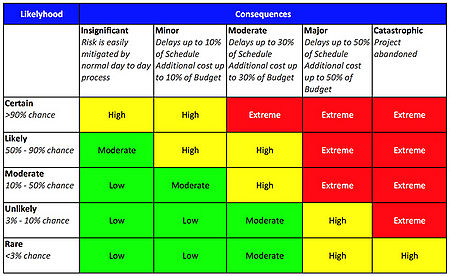
Purpose and Concept


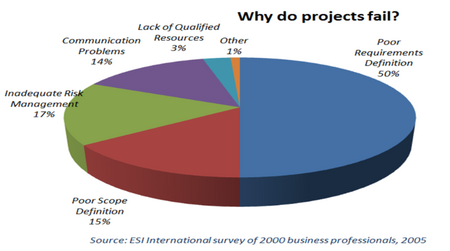
Importance
Applications
Expert Opinion
Expected Monetary Value (EMV)
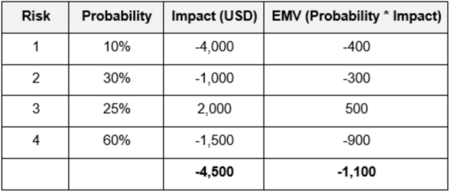
Statistical Sums

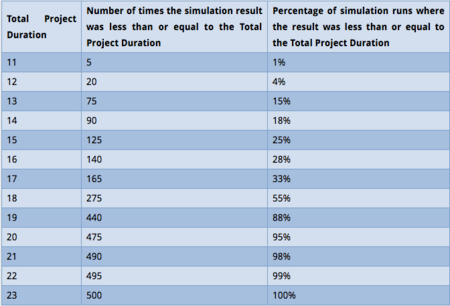
Monte Carlo Analysis or Simulation
For example, if there are three tasks required in an e-learning project. Best case, most likely, and worst case estimates of all the tasks required are given in figure 6. It can be seen that the project is most likely to complete in between 11 and 23 days. Now for example, if Monte Carlo simulation is run 500 times generating random values between 11 and 23. The total number of times the simulation result was less than or equal to projected duration is calculated as shown in figure 5. Then, probability of each projected duration is calculated and distributed as shown in figure 6. It can be seen that, from figure 4, the most likely projected completion time is 17 days. But, as per figure 6, Monte Carlo simulation shows that likelihood of project completion in 17 days is almost 33%. Whereas, likelihood of project completion in 19 days is 88%. Hence, it can be estimated that the project will most likely complete in 19 to 20 days. (http://quantmleap.com/blog/2010/07/project-risk-management-and-the-application-of-monte-carlo-simulation/) Monte Carlo simulation is usually used in cost and schedule estimation. It can also be used in large projects or programs. The benefits of using Monte Carlo are easiness of tool, numerical estimation, and greate level of confidence (http://quantmleap.com/blog/2010/07/project-risk-management-and-the-application-of-monte-carlo-simulation/). Whereas, drawbacks or challenges are the use of right distribution as wrong distribution may lead to wrong results, input estimates as right estimates are required to produce right results, and use of right mathematical formula in the software (http://abovethelaw.com/2016/05/finance-and-law-the-pros-and-cons-of-monte-carlo-simulations-in-valuation/).
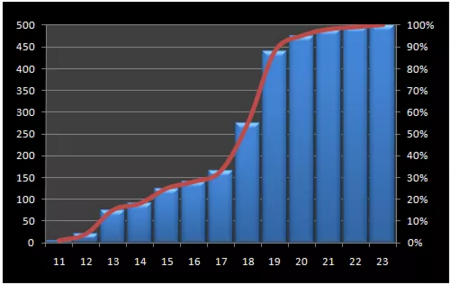
Decision Trees
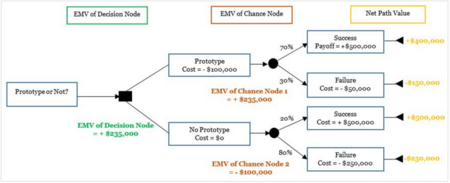
Limitations and Challenges
Annotated Bibliography
References
- ↑ 1.0 1.1 1.2 1.3 [Duncan W. R., “A Guide to Project Management Body of Knowledge (PMBOK)”, PMI Standards Committee, (2013).]
- ↑ [Bernstein P.L., “Against the Gods: The remarkable story of risk”, John Wiley & Sons, New York, (1996).]
- ↑ [Aven T., “Risk assessment and risk management: Review of recent advances on their foundation”, European journal of operational research, (2016), Vol. 253, No. 1, pp. 1-13.]
- ↑ [Yildiz A. Z. et al, “Using expert opinion for risk assessment: a case study of a construction project utilizing a risk mapping tool “, Procedia - Social and Behavioral Sciences, (2014), Vol. 119, pp. 519-528.]
